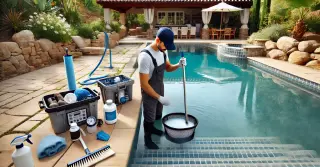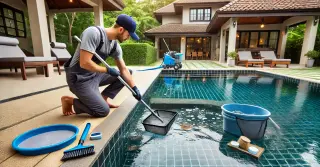Pool Chemical Balance Plainview MN

Ensuring the right chemical balance is essential for a safe and enjoyable swimming experience. Proper chemical levels prevent the growth of algae and bacteria, ensure clear water and protect pool surfaces and equipment.
- Maintaining Proper pH: Your pool's pH level indicates its acidity or alkalinity. Optimal pH levels range from 7.2 to 7.6. Acidic water from low pH can irritate skin and corrode equipment. Alkaline water from high pH causes cloudiness and scaling. Frequent pH testing and adjustments is essential to maintain a comfortable and safe swimming environment.
- Keeping Chlorine Balanced: Chlorine is essential for pool hygiene, destroying bacteria, algae, and other harmful pathogens. The ideal chlorine level should be between 1-3 ppm (parts per million). Too little chlorine can lead to unsanitary conditions, allowing bacteria and algae to thrive. Too much chlorine can cause skin and eye irritation and produce a strong chlorine odor. Frequently checking and balancing chlorine levels maintains sanitation and comfort.
Balancing AlkalinityTotal alkalinity is a crucial element of pool chemistry. Alkalinity buffers pH levels, avoiding sudden pH changes. Proper total alkalinity levels range from 80 to 120 ppm.
- Preventing pH Swings: Proper alkalinity levels help stabilize pH levels, preventing rapid pH changes that irritate skin and damage surfaces. If alkalinity is too low, pH levels can fluctuate wildly, making balance maintenance challenging. Excessive alkalinity results in cloudy water and scaling. Regularly testing and adjusting alkalinity levels is crucial for stable and balanced water.
- Balancing Calcium Levels: Calcium hardness refers to the amount of dissolved calcium in the pool water. Optimal calcium hardness levels are between 200-400 ppm. If calcium levels are too low, the water becomes corrosive, damaging pool surfaces and equipment. Excessive calcium causes scaling and water cloudiness. Regularly testing and adjusting calcium hardness is important for protecting your pool and ensuring clear water.
Using Pool Chemicals SafelyProper handling and storage of pool chemicals is vital for safety and chemical performance. Keep chemicals in a cool, dry location, away from direct sunlight, children, and pets. Always follow the manufacturer's instructions for dosing and application.
- Proper Chemical Measurement and Mixing: Accurately measuring pool chemicals is crucial for maintaining balance. Using too much or too little can disturb chemical balance and water quality. Always use a clean, dry measuring tool and never mix chemicals directly with each other. Mix in water as needed, following guidelines carefully.
- Chemical Reaction Awareness: Some pool chemicals can react dangerously when mixed. For example, chlorine and acid should never be mixed. Knowing these interactions avoids accidents and ensures safe use. Keep chemicals separate and handle with caution to avoid harmful reactions.
Ensuring the right chemical balance in your pool is essential for a safe, clean, and enjoyable swimming environment. By frequently testing and balancing pH, chlorine, alkalinity, and calcium, you ensure optimal water quality.
Safe handling and storage of pool chemicals further ensure the health and safety of your pool and its users.




